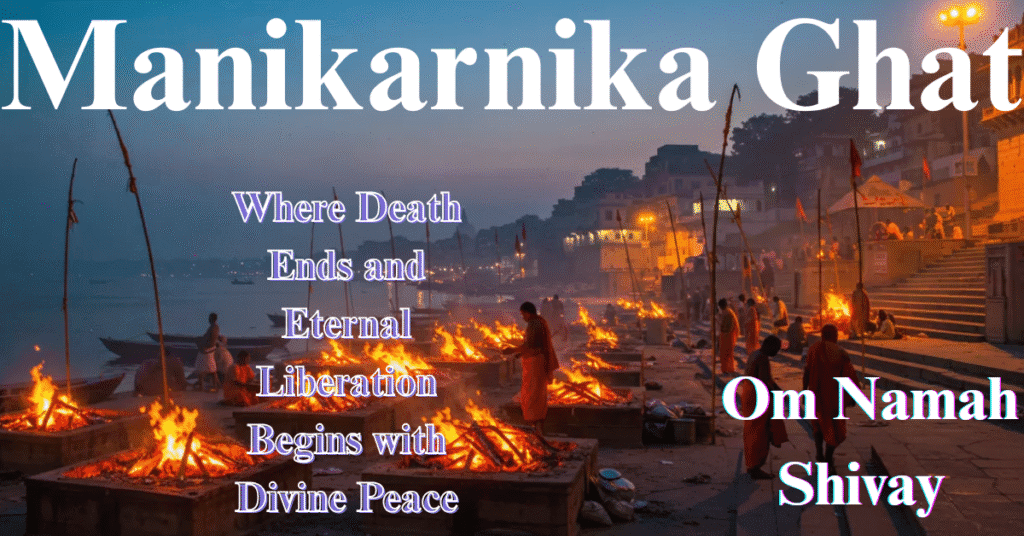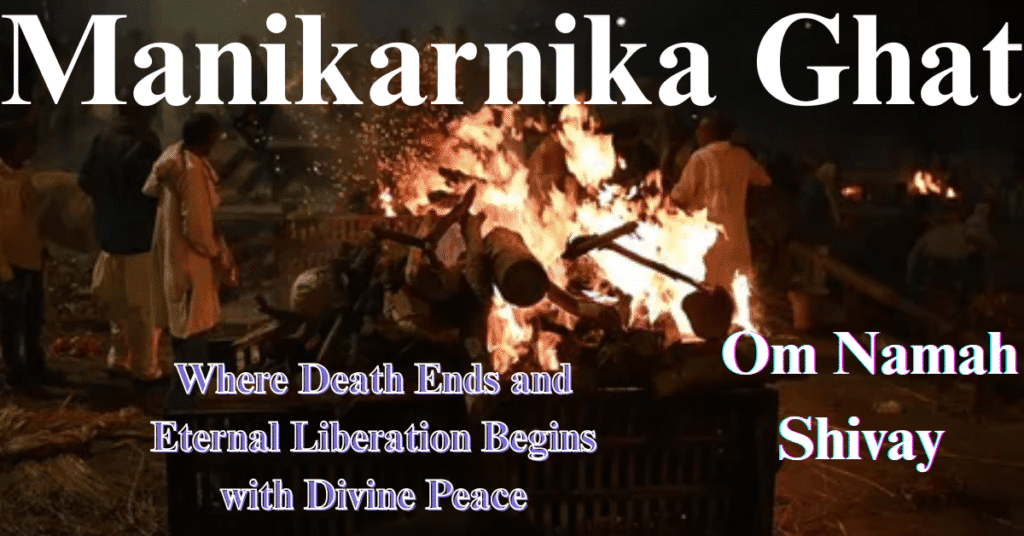
Table of Contents
Manikarnika Ghat
Manikarnika Ghat : On the ghats of the Ganga in Varanasi (Kashi), one ghat stands apart in both aura and purpose—Manikarnika Ghat. Revered as the holiest cremation ground in Hinduism, this sacred site is not a place of fear but of freedom from rebirth. Here, death is not an end—it is a spiritual graduation. With over 300 cremations a day, this ghat is the ultimate symbol of the Hindu belief in moksha, or liberation from the cycle of life and death. A Sacred Intersection of Life and Death
The History and Origins of Manikarnika Ghat
Etymology and Mythological Roots
The name Manikarnika is a combination of two Sanskrit words—Mani (jewel) and Karnika (ear). According to Hindu mythology, Goddess Parvati once lost her earring (mani-karnika) while bathing at this spot. Lord Shiva instructed the sacred fire (Akhand Agni) to be lit here for cremations, making it eternally sacred.
Legend also says that Lord Vishnu meditated here for thousands of years and dug a well with his chakra. This well, known as the Chakra-Pushkarini Kund, still exists and is considered spiritually purifying.
Why Is Manikarnika Ghat So Spiritually Important?
In Hinduism, Varanasi is believed to be founded by Lord Shiva. It is said that anyone who dies or is cremated in Varanasi, especially at Manikarnika, attains moksha—freedom from the cycle of rebirth (samsara). This belief makes the ghat a magnet for the dying, who come here hoping for a spiritual release.
The Bhagavad Gita (Chapter 2, Verse 22) beautifully summarizes this view:
“As a person sheds worn-out garments and wears new ones, the soul casts off its worn-out body and enters a new one.”
Manikarnika affirms this eternal truth every day.
Daily Rituals at Manikarnika Ghat: A Glimpse into Divine Farewell
The cremation process at Manikarnika Ghat follows strict traditional Hindu rituals:
- Preparation of the Body
The body is first bathed in the Ganga River, then smeared with sandalwood paste and wrapped in clean white cloth. - Final Journey
Carried on a bamboo stretcher, the body is paraded through the narrow alleys of Varanasi. Family members chant “Ram Naam Satya Hai”—meaning “The name of Ram is truth”. - Cremation Ceremony
The eldest son performs the last rites and lights the pyre using the sacred eternal flame (which has allegedly never gone out for over 3,000 years). - Immersion of Ashes
The ashes are then immersed in the Ganges, completing the spiritual journey.
No modern contraptions, no artificial decorations—just ritual, reverence, and release.
The Akhand Agni: The Eternal Fire of Liberation
One of the most mystical aspects of Manikarnika is the Akhand Agni (eternal flame) that has never been extinguished. It is this flame that is used to light every cremation pyre at the ghat. Believers hold that this fire was ignited by Lord Shiva himself.
Lord Shiva and the Taraka Mantra: A Divine Whisper at Death

According to Hindu scriptures, Lord Shiva whispers the Taraka Mantra—a powerful chant meaning “ferrying across”—into the ears of the dying at Manikarnika. It is said that:
“Those who die in Kashi are whispered the mantra by Shiva and are ferried directly to liberation.”
This belief adds immense spiritual value to dying here, making it a divine privilege rather than a sorrowful event.
Stories and Realities from the Ghat
- Dom Community: Cremations are carried out by the Dom caste, traditionally considered the caretakers of cremation. They are the keepers of the sacred flame and an integral part of Manikarnika’s history.
- Waiting for Death: There are Mukti Bhawans (liberation homes) near the ghat where the elderly check in to spend their final days near the holy site.
- Living with Death: Unlike the West, where death is hidden behind hospital curtains, at Manikarnika, death is public, constant, and spiritual. Even young children grow up witnessing the fire, yet there is no fear—only respect.
Nearby Spiritual Sites You Should Visit
- Kashi Vishwanath Temple – A Jyotirlinga of Shiva, symbolizing life’s impermanence and divine presence.
- Chakra Pushkarini Kund – The mythological well dug by Vishnu, adjacent to Manikarnika.
- Scindia Ghat – Home to submerged temples that sink a little more each year.
- Dashashwamedh Ghat – Don’t miss the grand Ganga Aarti performed daily at dusk with fire, chants, and conch shells echoing through the skies.
Lessons You’ll Learn from Manikarnika Ghat
- Death is not the end, but a transition.
- Time is precious. Use it truthfully.
- Forgive freely—grudges don’t cross over with you.
- Detach from materialism—it holds no value at death.
- Culture, faith, and tradition are eternal legacies.
Why Do People Come to Die in Varanasi?

Yes, people actually travel to Varanasi to die. Many believe:
“If I die in Kashi, I will not be reborn.”
This belief turns death into a reward, not a punishment. For those who come here, death in Varanasi is not a tragedy—it’s a spiritual fulfillment.
Modern Relevance and Preservation
While Manikarnika remains untouched by modernity in its rituals, concerns about pollution and overcrowding are rising. Several NGOs are now working to promote eco-friendly cremation methods, while still preserving ritual purity.
Conclusion: Manikarnika Is Not About Death—It’s About Truth
Visiting Manikarnika can be a life-altering experience. It forces you to confront what is inevitable and teaches you to live more mindfully. You leave not depressed, but spiritually awakened.
Because only when you face death, do you truly begin to live.
Also Read This :
Sawan 2025: Dates, Spiritual Significance, Rituals, Regional Calendars & Scientific Insights
ManikarnikaGhat, #Varanasi, #Kashi, #GangaGhat, #HinduRituals, #Moksha, #SpiritualIndia, #DeathAndLiberation, #CremationRituals, #LordShiva, #TarakaMantra, #HinduBeliefs, #SacredIndia, #VaranasiDiaries, #ManikarnikaStories, #EternalFlame, #GangaRiver, #SpiritualTravel, #IndianCulture, #SoulLiberation
!! Har Har Mahadev !!


